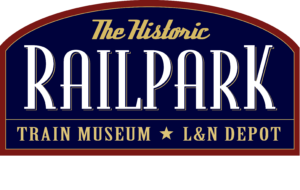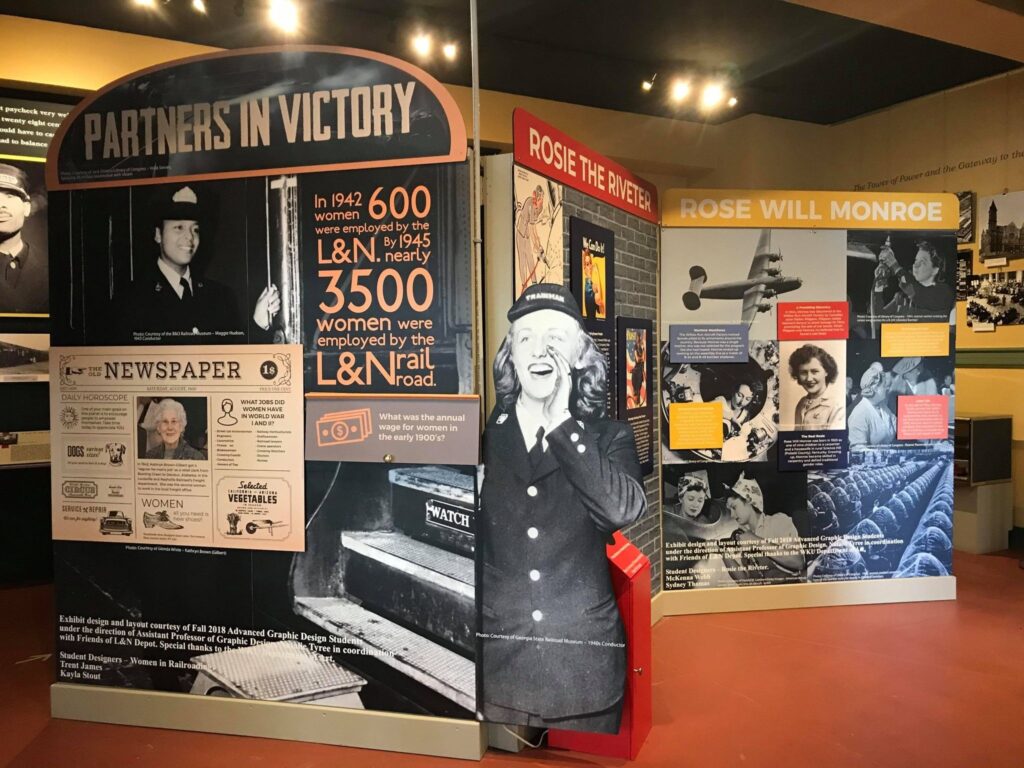Women In Railroading – Rosie the Riveter
On May 29, 1943, the Norman Rockwell Rosie illustration was published on the cover of The Saturday Evening Post. Today, perhaps the most famous of all the Rosie imagery is “We Can Do it,” created by J. Howard Miller and published by Westinghouse. Now the 8oth anniversary of that cover is upon us.
The Historic RailPark & Train Museum is now home to an exhibit that pays homage to “Women in Railroading”. Friends of L&N Depot unveiled the exhibit, Phase 2 of “Railroads Go to War” highlighting “Women in Railroading” and “Rosie the Riveter.”
This interactive exhibit highlights the historical significance that women contributed to the wartime efforts and the vital role they served in the railroads. While the national effort was of great importance, we have a local connection. Kathryn Brown Gilbert, a local Bowling Green celebrity, is featured under “Women in Railroading.” The focus of Phase 2 is on Kentucky women, like Kathryn and Rose Will Monroe. The subject matter of this new exhibit is of interest to women and men, along with students of all ages.
Sallie Curtis Murphy, a native of Maryland, was the first woman employed by the Louisville & Nashville Railroad in October,1882. She worked taking dictation and had the distinction of being the first woman shorthand writer in Louisville, a profession previously held only by men.
To replace thousands of men going off to World War I (1914-1918), hundreds of women were employed by the L&N as typists, clerks, agents, operators, ticket sellers, car cleaners, and crossing watchers. In 1918, the U.S. federal government implemented new wage levels. Women received the same pay as men for similar work. In 1919, the average annual wage was $1,484 and in 1920 it was $1,830.
During World War II (1939-1945), women were hired to fill many vacancies left by men. Besides filling the same positions filled during WWI, women also worked as engineers, locomotive firewomen, brake women, crossing guards, conductors, street-care motor women, hewers of ties, railway horticulturists, draftswomen, railroad lawyers, presidents or vice presidents of steam railroads, crane operators, doctors and nurses in railroad hospitals, and hostesses on trains. In 1942, 600 women were employed by the L&N By 1945, nearly 3,500 women were employed by the L&N.
During World War II, “Rosie the Riveter” was an iconic figure representing the women who worked in factories and shipyards during the war. The term “Rosie” was used to refer to all women who worked in defense industries and not just riveters.
Rosie the Riveter was a composite of the experiences of many real women.
In 1942, the term Rosie the Riveter was first used in a song of the same name written by Redd Evans and John Jacob Loeb. Rose Will Monroe, from Kentucky, happened to best fit the description of the worker depicted in the song.
By 1944, over 50,000 white females performed war work of various kinds throughout Kentucky (Holl, p. 54). Included were women such as Rose Bonavita, Rosalind P. Walter, Geraldine Hoff Doyle, Edna Winstead, Dorothy Louise Powell, Mildred Harris, Anna McDevitt, Peggy Terry, Virginia Burns, Rose Will Monroe, and thousands more. Edna Winstead, Dorothy Louise Powell, and Rose Will Monroe were from Kentucky.
Not until 1943 did black women manage to secure work in war plants. Margaret Peyton Lutes Hayden, Nova Hays Downs, Everylee Ashby, Fannie Lane, and Elizabeth Lawson were from Kentucky.
With the help of many, the entire exhibit was brough to fruition by volunteers. Western Kentucky University’s Department of Art Asst. Prof. Natalie Tyree and WKU students, Trent James, Kayla Stout, McKenna Webb, and Sydney Thomas worked to design the exhibits. A group of RailPark volunteers who have also served as board members in the past, were a part of the planning, and research of the exhibit; Miliska Knauft, Joe Cox, Mike Dowell, Rick Williams, Jim Lockwood and Larry Bailey.
This exhibit was made possible with grant funding provided by the Kentucky Humanities Council and the National Endowment for the Humanities.
I invite you to visit the museum during regular operating hours to see the exhibit. The completed “Railroads Go to War” collection can be seen at in the museum at the Historic RailPark & Train Museum. To find out more about our non-profit museum, membership, and how to be part of our events and volunteer opportunities, visit our social media or website. I hope to see you soon at the RailPark
Jamie Johnson
Executive Director


